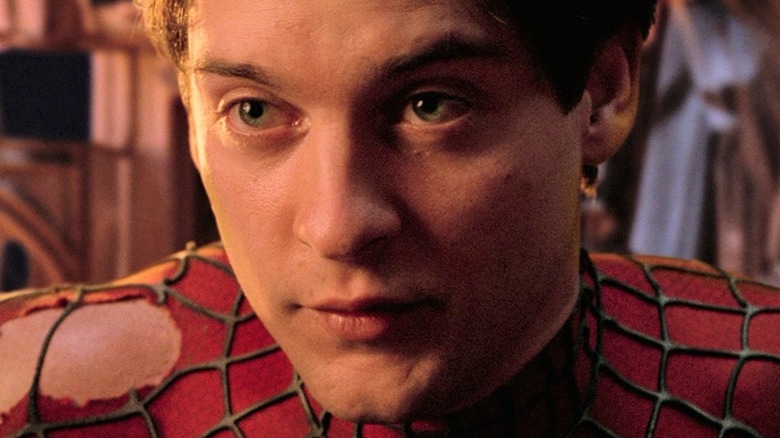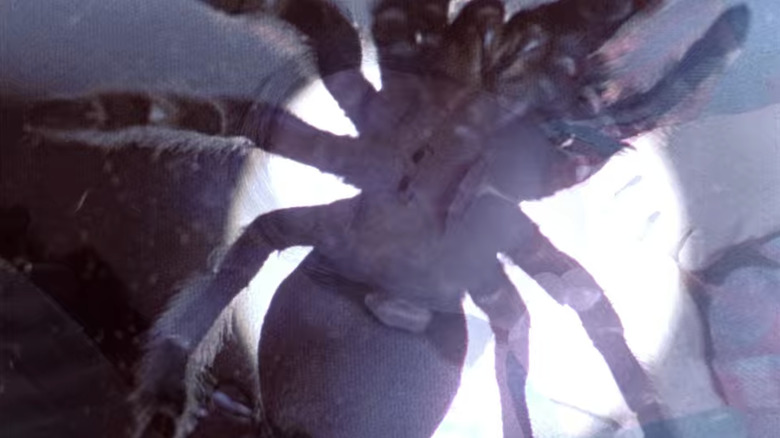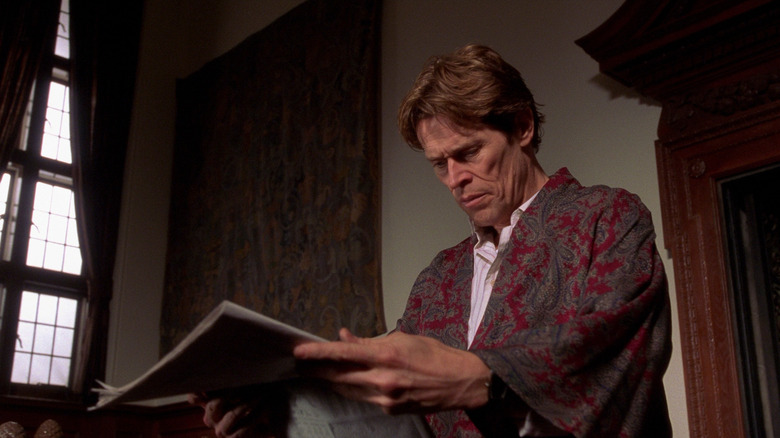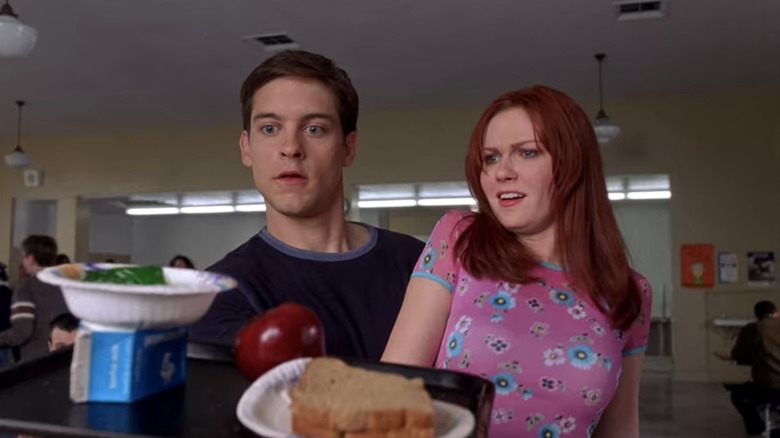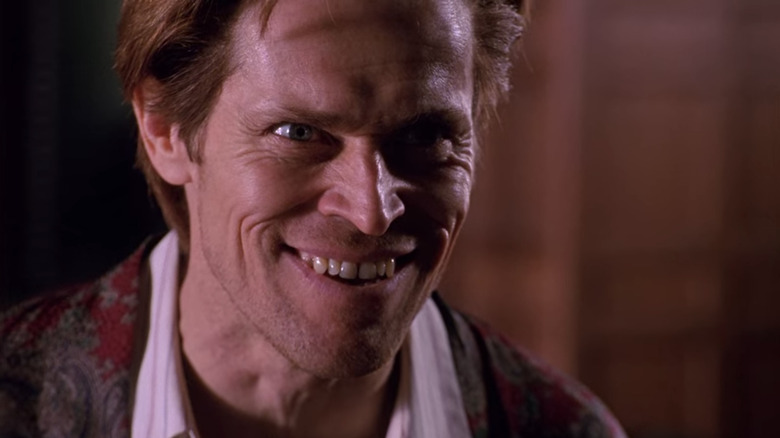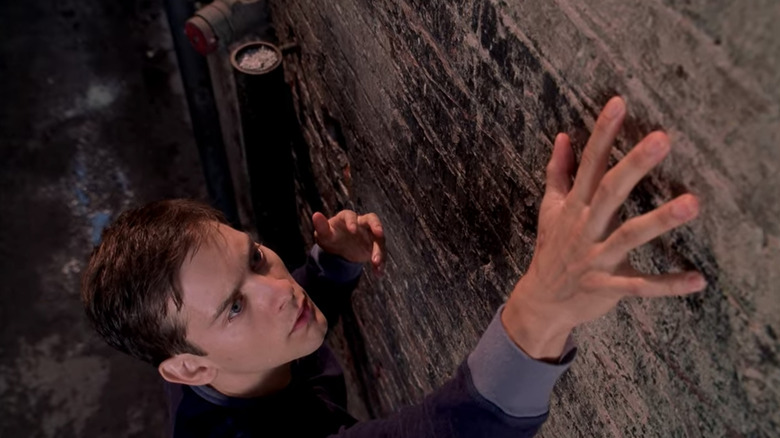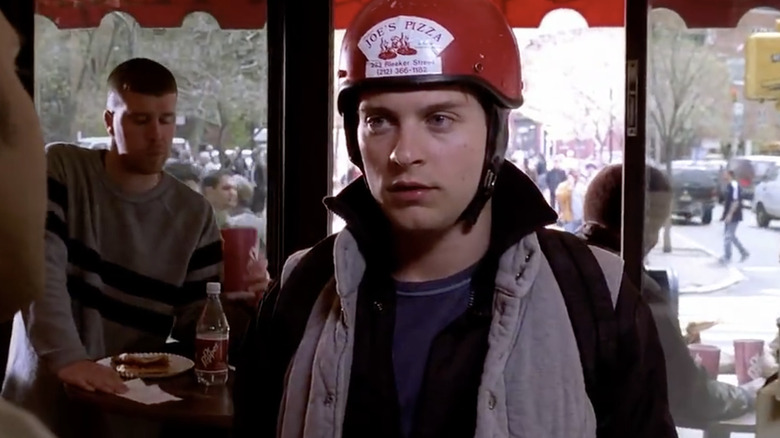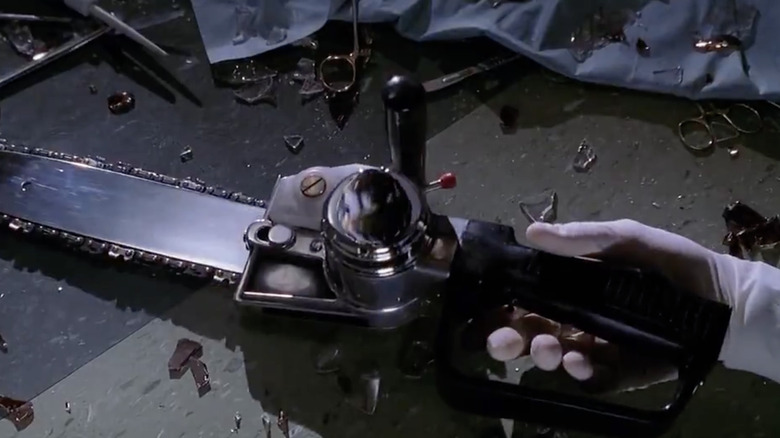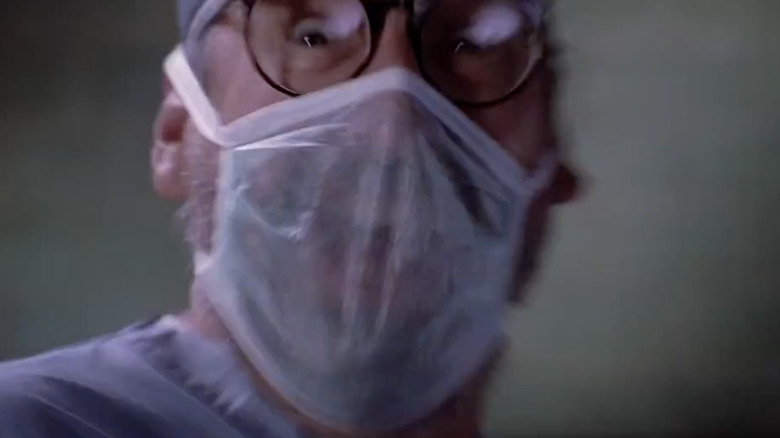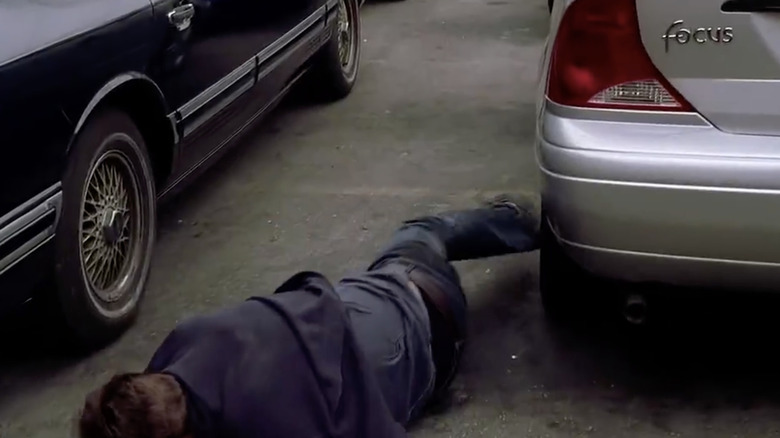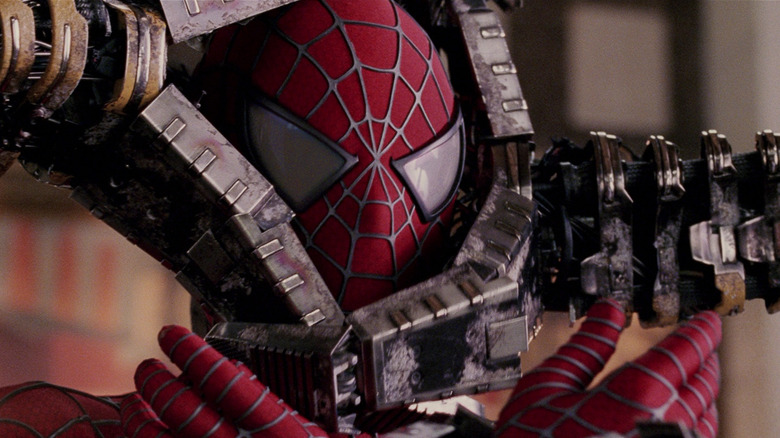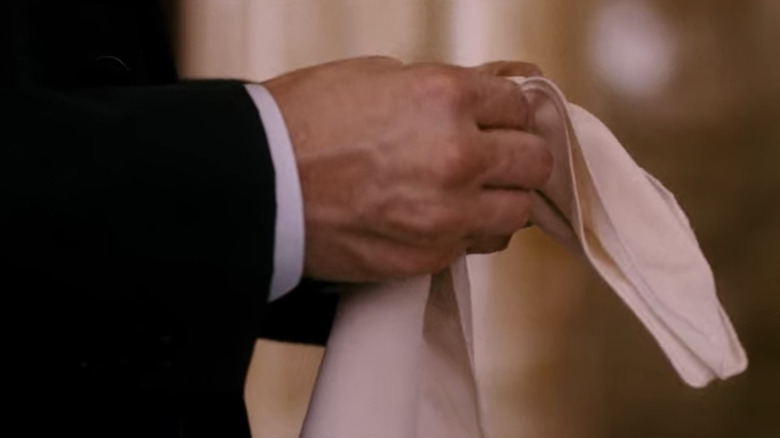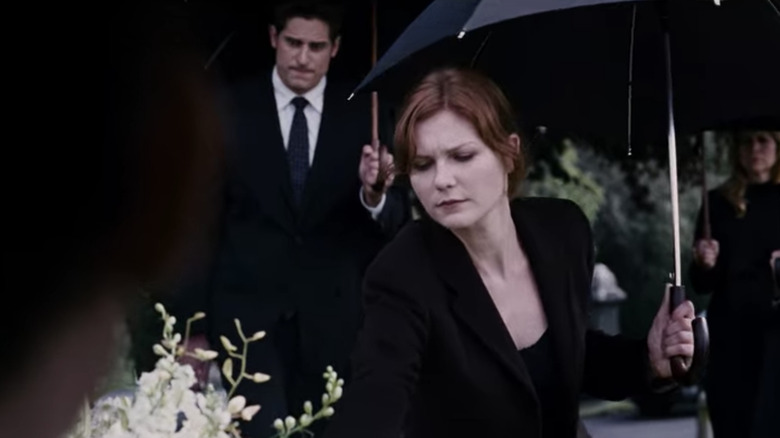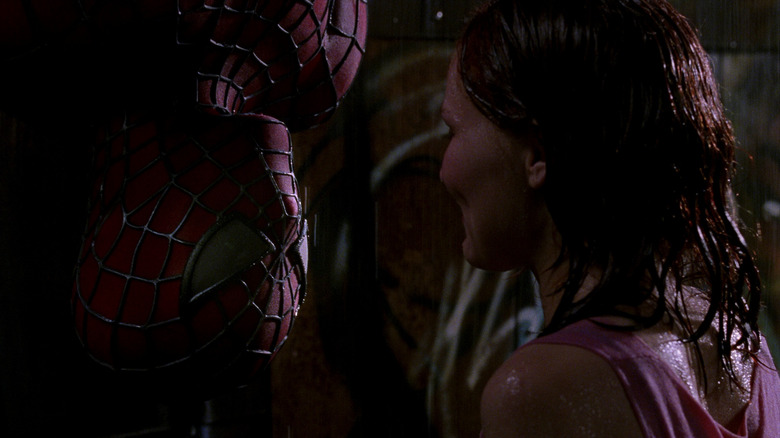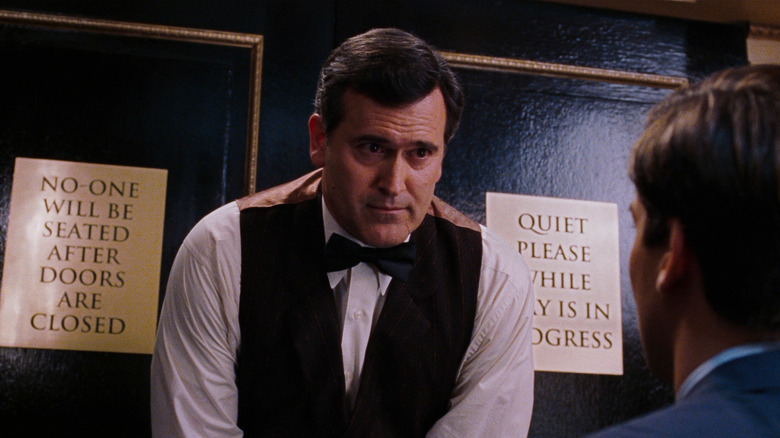Things In Sam Raimi's Spider-Man Trilogy You Only Notice After Watching It A Second Time
Believe it or not, the original "Spider-Man" was released two decades ago. In that time, superhero films have dominated cinemas, streaming services, and fanbases as the mainstream genre film. But it wasn't always so.
Sure, Marvel films existed before Kevin Feige and company came to town with 2008's "Iron Man." But previous efforts were always a little off the beaten path, with early entries like "Howard the Duck" and "The Punisher" achieving cult status but failing to win Hollywood over. A couple of "Blade" and "X-Men" movies later, Marvel had its foot in the door. Enter: Sam Raimi, a director who got his start in the horror scene but who would go on to make a total of three "Spider-Man" films starring Tobey Maguire, Kirsten Dunst, and James Franco.
And if you were a moviegoer (or a kid) during the early noughties, chances are you have a soft spot for the trilogy. It's iconic, influential, and set a precedent for the emotional storytelling and action set pieces audiences could expect from superhero fare. Given Raimi's talents as a director, all three films are packed with small details that are easy to miss on a first pass, and since many Marvel fans have returned to Raimi's original "Spider-Man" films after the multiverse-powered shenanigans of "No Way Home," here are a handful of tasty tidbits and sneaky Easter eggs you can keep your eyes out for as you rewatch the trilogy.
There's a shot from an infamous horror film during Peter's transformation
In the first installment of Sam Raimi's "Spider-Man" trilogy, Peter Parker returns from his high school field trip drenched in sweat and in desperate need of a nap. Through some churning combination of dumb luck and fate, Peter's trip to the Columbia University genetics lab is about to change his life. A mutated "super spider," possessing numerous abilities from three different arachnids, repelled onto the unassuming nerd's outstretched wrist, chomping down on Peter's hand, leaving two ominous puncture marks in its wake.
Stumbling into the privacy of his room, Peter begins to lose consciousness as he lies shivering on the floor. As the Columbia scientist's presentation replays in his mind, we're treated to some quick, blink-and-you'll-miss-it frames of a giant arachnid looming large over the camera between bright flashes. Now, if you're a fan of Italian supernatural horror (and given Sam Raimi's previous work in the horror genre, there's a solid chance you might be), you'll recognize that big ol' spider from Lucio Fulci's 1981 film "The Beyond." For everyone else, the director's commentary on "Spider-Man" will provide some enlightening context. Supposedly, with little money in the budget to execute Peter's fever dream as scripted, Bob Murawski (one of the film's two editors) came to the rescue, splicing together footage from the opening credits, Raimi's earlier dark superhero film "Darkman," and yes, Fulci's "The Beyond."
If you've seen "The Beyond" you know that explaining why, exactly, the spider shot happens is no easy task (the film is notoriously dreamlike and difficult to describe). But to make a long story short, a character doing research on a haunted house falls off a ladder thanks to a well-timed lightning strike and is eaten alive by spiders. Peter Parker should count himself lucky that he just got nibbled on!
Norman Osborn got his penthouse from Bruce Wayne
Maybe when you first took a gander at Norman Osborn's high-rise penthouse, you thought, "Huh, that looks like what I'd expect a rich dude's apartment in New York City to look like." Maybe the more observant among you even clocked the wide array of tribal masks adorning the walls, a clear indication of why a high-society scientist like Osborn would be so quick to adopt a masked persona. But, perhaps on a second or third pass, you may notice that Osborn's condo looks a bit familiar.
Great instincts, kid! The set for Norman Osborn's penthouse was filmed on the Warner Brothers lot. And the condo set had already made an appearance in a superhero film, namely, Tim Burton's 1989 film "Batman," where it appeared as Wayne Manor. According to the director's commentary, Raimi and the rest of the team were careful to shoot the set in different ways so that the similarities wouldn't be distracting. Funnily enough, per the crew commentary, composer Danny Elfman was enamored with the set, perhaps sensing his affinity with "Batman," which he also scored.
Tobey Maguire really did that lunch tray stunt
After waking up with super powers, Peter Parker does what any self-respecting nerd would do — attend school like nothing happened. While pensively munching on some fries in the cafeteria, Mary Jane struts past Peter and slips on a spilled carton of orange juice. Sensing the accident in advance with his newly acquired Spidey-senses, Peter quickly catches Mary Jane and (more impressively) uses her yeet-ed tray to catch her food. Peter probably deserved more than a "wow," Mary Jane, but then again, so does Tobey Maguire.
As relayed in the filmmaker and cast commentary, Maguire did that stunt for real. "That's not CGI by the way," Kirsten Dunst (Mary Jane) explains. "That's all real," chimes in producer Laura Ziskin. While some sticky tape was used to give Maguire more control of the lunch tray, the big secret to getting the shot that you see in the film was simply many, many takes. As Raimi explains in his commentary, the moment was very nearly scrapped due to time and budget, leaving the crew with only a day to make the movie magic happen. This isn't too dissimilar to an approach frequently used by Jackie Chan, which boils down to "mess up 99 times but only show the one time you got it right."
Green Goblin and Norman Osborn have different teeth
Just past the mid-way mark of 2002's "Spider-Man," Norman Osborn has a full-on conversation with the giggling maniac that makes up his genetically-enhanced alter-ego, the Green Goblin. The exchange is incredibly dramatic and a tour de force of vulnerability and camp on Dafoe's part, inhabiting both roles with equal passion and endowing the film's antagonist with menace and pathos in equal measure.
But did you get a look at his teeth?
Let us explain. In a tiny detail that's understandably easy to miss when you're lost in Dafoe's acting chops, the Green Goblin and Harry Osborn have different sets of teeth. Where Norman has the straight, perfect smile you'd expect of someone with the cashflow to afford dental, the Goblin's grin has a lot more character. Dafoe's unique teeth are one of the many quirks that distinguish the actor amongst a sea of thespians; he has a unique look and his pearly whites are part of what makes him look as interesting as he does. While it appears that Dafoe wore dental prosthetics as Norman Osborn, his reflection as the Green Goblin sported Dafoe's own, natural teeth.
Danny Elfman's score synchs up with Spider-Man's movements
On a first watch of a film, you're often taking things in as a whole rather than noticing all the tiny details. But on subsequent watches, the minutiae and craft of individual scenes are easier to untangle and appreciate. One such detail in 2002's "Spider-Man" is a little auditory technique known as "Mickey Mousing," which absolutely litters Danny Elfman's score.
In essence, the term refers to whenever accompanying music matches the movement on screen. As its cutesy name suggests, Mickey Mousing was huge in the early days of animation, where music could be used to emphasize motion and reinforce the impact of character actions.
While an old-school animation technique may seem out of place in a big-budget superhero film, those familiar with Sam Raimi's previous filmography will know that one of the director's hallmarks is directing live-action like a cartoon. ("Evil Dead 2" is full of physical comedy that would be right at home with "Looney Tunes." And likewise, "Darkman" has a complete lack of respect for the laws of physics.) One of the most iconic moments of Mickey Mousing in "Spider-Man" is when Peter first attempts to climb a wall, the score responding to each placement of his hand, giving the scene a heightened — pun intended — feeling.
The location of Joe's Pizza is a reference to Dr. Strange
If you're reading this, there's a very good chance that you're a Marvel fan, a Sam Raimi fan, or (get this) a Sam Raimi fan and a Marvel fan. If you fall into the latter category, you're no doubt aware that Raimi directed "Doctor Strange in the Multiverse of Madness." What might have slipped your notice is the sneaky nod to the Sorcerer Supreme in 2004's "Spider-Man 2."
When we first reconnect with Peter, he's pining away after Mary Jane while delivering pies for Joe's Pizza. While the real Joe's Pizza (because, yes, it is a real pizza joint) is located in the West Village on Carmine Street, a different address is printed on the sticker that adorns Peter's red moped helmet. If your eyes are wandering on a repeat viewing (or if you're looking for it), you'll notice that Joe's Pizza is located on Bleecker Street. Why change the location if Joe's Pizza is a real place? After all, the phone number is real. Well, if you're a fan of Dr. Strange, you'll recognize Bleecker street as the home of the Sanctum Sanctorum, the headquarters of the reality-bending doctor.
There is actually a second Dr. Strange reference in "Spider-Man 2." While brainstorming a catchy name for Dr. Otto Octavius, Hoffman (played by Raimi's brother, Ted) suggests "Doctor Strange," to which J. Johan Jameson replies, "That's pretty good ... but it's taken!"
There's a pretty groovy reference to Evil Dead II
Theoretically, if you were compiling a list of the moments in Marvel movies that most closely drew from the horror genre, Dr. Otto Octavius' surgery scene has to be right up there. After the public demonstration of his new invention — metallic, tentacle-like arms with artificial intelligence fused to the wearer's spine — goes horribly wrong, Octavius is rushed to the hospital. The cracked inhibitor chip keeping the arms' AI from his nervous system (which, by the way, should have been sealed in more than just glass) means that the metallic harness must be removed surgically. Only, the arms (which are now very much sentient) aren't too keen on this.
While Octavius remains unconscious and the bone saws start whirring, the arms begin to twitch. The screams of surgeons pierce the air as the arms suddenly start to slice, throw, and drag their victims with unnerving speed. But, as Raimi is wont to do, the horror has a remarkably comedic bent to it. And there's no greater evidence of the director's giddy fusion of charm and terror than his nod to an early work that remains the high benchmark of the horror comedy genre: "Evil Dead II."
While he's in the grip of one of the claws, a surgeon spots a chainsaw via a glorious smash zoom. (Is a chainsaw a surgical instrument? Who's to say?) While the brave surgeon attempts to hack his way through his metal oppressor, more tentacles fly in for backup (in a shot hilariously reminiscent of another gag in "Evil Dead II" where an eyeball flies through the air). In the end, the surgeon's arm — severed by the frame itself — lies next to the dead chainsaw, a clear and adorable nod to Raimi's horror past.
There's a famous horror director hiding in the surgery scene
While some of the details and Easter eggs on this list may be within your grasp as an eagle-eyed viewer, we'd be shocked if anyone caught John Landis' cameo without knowing it was there in the first place. For those unaware, Landis is a genre director whose contemporaries include the likes of Joe Dante and Mick Garris. His 1981 horror comedy, "An American Werewolf in London," is widely considered a high watermark of practical effects thanks to an exquisite transformation sequence courtesy of Rick Baker. (Landis is also the subject of much controversy, due to his involvement with a helicopter accident on the set of 1983's "The Twilight Zone" that resulted in three deaths, two of them children).
You'd be forgiven for missing Landis' cameo for two reasons. First, the "Blues Brothers" director is wearing full PPE, leaving much of his face obscured in a very quick closeup. Second, the cameo in question takes place during the Doc Ock surgery massacre. Landis is but one of many, many surgeons getting absolutely destroyed by Doc Ock's metallic tentacles. Funnily enough, "Spider-Man 2" wasn't the first time Landis had made a cameo appearance in a Sam Raimi superhero flick as a doctor. He did just that in 1990's "Darkman."
Peter's fall takes an ironic turn
Over the course of "Spider-Man 2," the heroic web slinger is having, uh, performance issues. His abilities are waning, and while the reason itself isn't super clear, we're sure all the pressure of supporting Aunt May, attending university, and keeping New York City safe from a tentacled maniac might have something to do with it. It's a psychological issue, surely. And nothing jolts you out of a rut quite like jumping off a building. You know, to see if you've still got what it takes to be the hero your city needs.
The music surges as Peter Parker paces on the rooftop. He tells himself, "Strong focus on what I want," echoing Aunt May's sentiment that he needs to commit to a path in life. Peter sprints, and the slow motion seems to imply that he's got his mojo back. Then gravity takes hold, and Peter crashes down the alleyway, smashing into what else but a Ford Focus. He found his focus alright. And it had four wheels and reliable gas mileage.
Doc Ock's metal arms are full of personality
Move over, Tobey Maguire. Move over, Kirsten Dunst. Doc Ock's horrible, screaming metallic arms are the stars of "Spider-Man 2." A big part of what makes the not-so-good doctor's tentacles feel so compelling is that, with very few exceptions, the arms were a practical effect. There's a nearly 25-minute behind-the-scenes featurette on the "Spider-Man 2" DVD dedicated to the hard work it took to bring Doc Ock to the big screen, and the vast majority of it discusses his terrifying tentacles.
Together, the animatronic puppets weighed between 60 to 100 pounds. As the featurette frames things, the overall push was to only use CGI when absolutely necessary, favoring the economic and on-set boons of having something physical to work with. As Steve Johnson of Edge FX tells it, puppeteers were involved from the beginning of the development process to suss out "the performance and the attitude and the character of these tentacles." As Doc Ock actor Alfred Molina puts it, aligning his performance with that of the puppeteers (of which there were 16 in total, on-set) was crucial. "We had lots of long and detailed rehearsals with the puppetry team," the actor explains.
Molina inevitably endowed the tentacles with names — hefty Harry and Larry for the lower extremities and the slightly smaller Flo and Mo for the upper appendages. As Molina relayed in a 2004 interview with The Sydney Morning Harold, Flo was especially delicate and caring, undertaking tasks like lighting his cigar and removing his glasses.
Peter's scarred-over spider bite
In the first film, that super-spider bite leaves one heck of a goose egg. No, seriously, the next time you boot up the 2002 classic keep your eyes on the space between Peter's thumb and pointer finger while he's writhing in agony in his bedroom — that thing is the stuff of nightmares. Has Peter Parker tried biting any bad guys? Maybe he inherited some of that inflammatory power from his maker.
Anyway, given the aggressive reaction Peter experienced, it's no surprise that bite left a bit of a mark. And while it's very hard to spot, as one Reddit user points out, in "Spider-Man 3" you can catch a glimpse of a bite-sized scar on Peter's hand (though as another user counters, the placement isn't quite right, but maybe the altered location has to do with blocking and camera placement). All told, maybe Peter Parker should look into scar-concealing tattoos or something to keep his secret safe.
MJ's high school ex makes an appearance at Harry's funeral
First things first, you'd be forgiven for not clocking that Flash Thompson, Peter Parker's bully, is played by "True Blood" and "Magic Mike" actor Joe Manganiello. It was his first professional acting role, and beards are very good at making folks look like entirely different people. With that out of the way, here's a cute little detail from "Spider-Man 3." Okay, cute might not be the right word, but look at that, Flash showed up to Harry Osborn's funeral.
Granted, Flash comes off as a real jerk up to this point. He's pushy and rude to Mary Jane while he's dating her in the original "Spider-Man." He even mocks Harry at one point for coming from wealth ("What? Is your daddy going to sue me?") But clearly Flash went to therapy and did a lot of growing up between the first film and the third because there he is, hiding in the background of Harry's funeral. Now we don't know about you, but attending the funeral of high school acquaintances is a bit strange, so maybe Manganiello's appearance means that he's made things right with Mary Jane or even got close with Harry before he passed. Either way, good for you, Flash!
All the recurring significant alleyways
Sometimes filmmakers are forced to reuse locations out of necessity; maybe something wasn't in the budget or maybe it's possible to set-dress something to look completely different. Heck, on this list, we've already talked about how Norman Osborn's penthouse had a previous life as Wayne Manor in Tim Burton's "Batman."
Another interesting way to get more mileage out of the same location is to reuse it intentionally for narrative impact. The Sam Raimi "Spider-Man" films do just that ... specifically with alleyways. The alley where Mary Jane and Spider-Man did their famous MTV Movie Award-winning smooch is where Peter trashes his costume in the second film. And then, the alley where Peter discovers his powers in the first film returns in the third film as the alleyway where Pete tries to resuscitate Harry. Life, death, discoveries, and young love — so many life changing moments but only two, narratively rich alleyways.
Every Bruce Campbell cameo
Arguably one of the most endearing creative partnerships in film, Sam Raimi and actor Bruce Campbell first met in high school in Michigan. In the late 1970s, the duo teamed up on the Super 8 horror short "Within the Woods," which was explicitly created to entice investors for a feature film (which would go on to be 1981's "The Evil Dead"). If you're familiar with the pair's work together, a Sam Raimi movie can often feel like a game of "Where's Waldo?" Campbell has a final "gotcha" cameo at the end of 1990's "Darkman" and multiple cut cameos and a screen credit in 1995's "The Quick and the Dead." In fact, one of the (many) reasons Raimi disowns the 1985 flop "Crimewave" is because the studio wouldn't let him cast Campbell as the star (per Campbell's 2002 memoir "If Chins Could Kill.")
So you best believe that Raimi had his buddy on the horn when it came to "Spider-Man" cameos. And if you're coming to Raimi's work via Marvel's webslinger, you might not catch all the Campbell cameos the first go-round. Campbell appears as the swaggering wrestling announcer in "Spider-Man," the snooty usher who refuses to let Peter into Mary Jane's play late in "Spider-Man 2," and the sassy but supportive French maître d' in "Spider-Man 3." As for his personal favorite appearance? Supposedly, Campbell's favorite appearance was as the announcer. According to one Reddit user who met him, the actor proudly proclaimed, "I gave Spider-Man his name and his identity." Can't argue with that.
